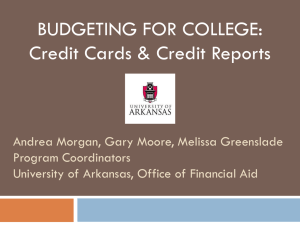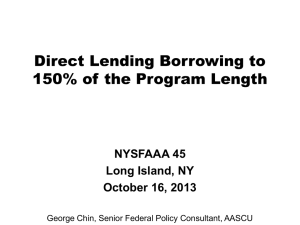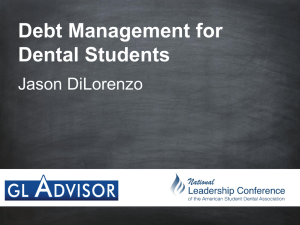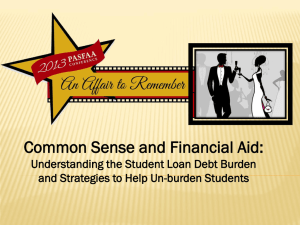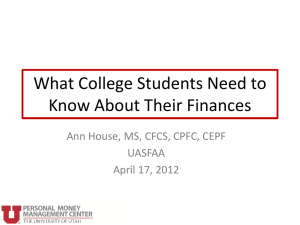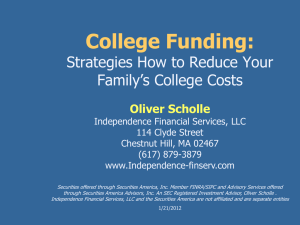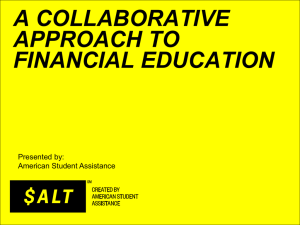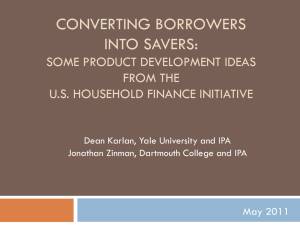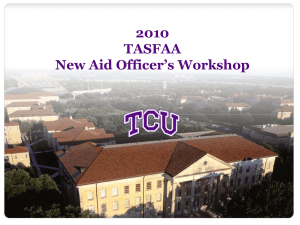Unit Personal Finance
advertisement
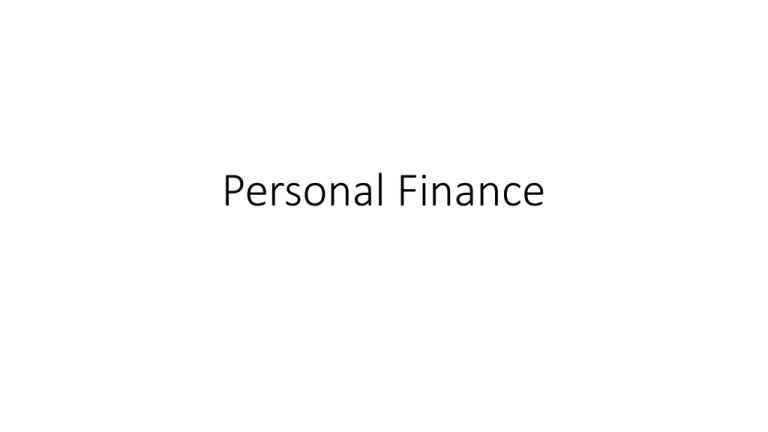
Personal Finance Higher Education- What are the costs & benefits associated with Higher Education • FASFA • Grants • COA- Cost of Attendance • Subsidized Federal Stafford Loans • Unsubsidized Federal Stafford Loans • Parent Plus Loans • For Profit education • Predatory lending Why higher education • Unemployment rates are directly tied to your level of education • Studies consistently show that attending college adds to your lifelong earnings • Difference between a high school graduate and a four-year degree—between $800,000 and $1 million • People who have attended some college • Report higher levels of job satisfaction • Typically live healthier lifestyles • Enjoy benefits such as insurance, paid vacation, a retirement plan, etc. Cost of Four-year College Tuition (averages) 1985 2009 One-year tuition, public college or university $2,784 $7,020 One-year total expenses, public college or university $7,674 $19,338 One-year tuition, private college or university $15,487 $39,028 Total cost for four years, public college or university $32,000 $80,000 Total cost for four years, private college or university $63,000 $160,000 Choosing • There are more than 6,000 colleges to choose from in the United States • Before you start searching, think about your goals • Some students already know they want to • Learn a trade or enter a specific profession • Obtain a degree, maybe in a specific field • About 80% of college students change their major at least once • Narrow down your list of potential colleges by identifying the characteristics important to you • Factors some students consider • • • • • Program or major you are considering College size Class size Location or distance from home Support programs • Ultimately cost matters but • Think about cost when making your final decision, not as much when starting your search • Consider your net out-of-pocket cost, not just the sticker price • Enter college costs graph • Which college would cost you the most to attend? • Sample private college—Willamette University-- $52,805 • Sample state college—University of Oregon--$24,075 • The answer seems obvious, but it isn’t as simple as comparing these numbers • When you look at the costs listed on the previous slide, you are looking at the college’s “sticker price” • More formally known as “Cost of Attendance” (COA) • Consists of direct and indirect costs • Direct costs are paid to the college • Tuition and fees • Room and board, if living on campus Paying for Higher Education FASFA • FAFSA = Free Application for Federal Student Aid • Determines eligibility for • • • • Most federal financial aid programs Many state financial aid programs Much of the aid colleges award from their own funds Some scholarship programs • www.fasfa.ed.edu • IT IS FREE, FREE, FREE! Types of federal financial aid • Need-based federal aid • Pell Grant • Work-study • Perkins loan • Subsidized Stafford loan • Non-need-based federal aid • Unsubsidized Stafford loan • PLUS loan • TEACH grant What can it be Used for? • Traditional colleges and Universities- OSU, UofO, Gfox • Community colleges- Portland Community College, Mt. Hood Community College • For Profit vocational schools- ITTech, UTI, Devry Subsidized and Unsubsidized Student Loans • During the in-school deferment, the obligation to repay a federal education loan is suspended while the borrower is enrolled at least half-time. • Payments of principal and interest are deferred (delayed) until the end of the grace period after graduation, when the borrower enters repayment on the loan. • To be eligible for any federal student aid program, the student must be: • A U.S. citizen or eligible non-citizen • Have received a high school diploma or the equivalent (e.g., GED) • To be eligible for any federal student loan program, the student must be: • Enrolled at least half-time in an accredited academic program • Not be in default on any existing federal student loan Subsidized Student Loans • With subsidized loans, the federal government pays the interest as it accrues. • To receive subsidized Federal Stafford loans, the student must: • Have financial need as determined by the FAFSA • Interest rate of 4.66% for the 2014-2015 academic year • Interest is subsidized while the borrower is in school Subsidized Stafford Loans undergraduate Grade Level Subsidized Stafford Loan Annual Loan Limits Freshman $3,500 Sophomore $4,500 Junior, Senior and Beyond $5,500 Cumulative Limit $23,000 Unsubsidized Loans • With unsubsidized loans, the interest is capitalized (added to the loan balance) if unpaid by the borrower as it accrues. This is in contrast with a forbearance, where the interest is the responsibility of the borrower on both subsidized and unsubsidized loans • Interest rate of 4.66% for the 2014-2015 academic year • Unsubsidized Loan Eligibility • Unsubsidized student loans are not need-based funds. Because of this, they are available to most federal aid recipients, regardless of financial circumstances. Unsubsidized Stafford Loans undergraduate Grade Level Unsubsidized Stafford Loan Annual Loan Limits Dependent Student Unsubsidized Stafford Loan Annual Loan Limits Independent Student Freshman $5,500 $9,500 Sophomore $6,500 $10,500 Juniors, Seniors and Beyond $7,500 $12,500 Cumulative Limit $31,000 $57,500 Education debt dangers • student loan debt has reached a new milestone, crossing the $1.2 trillion mark — $1 trillion of that in federal student loan debt. • The average borrower will graduate $26,600 in the red. • one in 10 graduates accumulate more than $40,000. • National accreditation compared to regional accreditation • ITT Vs OSU • Regionally accredited schools are predominantly academically oriented, non-profit institutions. Nationally accredited schools are predominantly for-profit and offer vocational, career or technical programs Debt Averages • Most debt is mortgage based (considered good debt) Cnn.com • Student Loans are also considered good debt “IF” it does not represent more than 20% of income post education • The average American household with at least one credit card has nearly $15,950 in credit-card debt (in 2012) • 35% of Americans have debt in Collections (180 days past due) • The 77 million Americans with debt in collections owe an average of $5,200. • That includes debt from credit card bills, child support, medical bills, utility bills, parking tickets or membership fees. MCSP • MCSP stands for the Matched College Savings Program which is a matched savings account (also known as an individual development account, or IDA) for current and future students to pursue post-secondary education. The MCSP program is currently available to residents of Oregon and Washington to attend participating educational institutions. • http://mycollegesavings.org/ • Every dollar a student saves in MCSP is matched 5:1. Students are able to set intermittent goals to draw down from their savings and match once every twelve months, or at the end of their entire savings period. Students must save for a minimum of six months; the maximum savings period is thirty-six months. • MCSP requires that students: • Save at least $25 each month throughout their participation in the program; • Complete at least ten hours of financial education and training specific to their educational level and goals; • Create a goal-oriented educational and financial plan. To qualify, students must: • Be enrolled in a partner MCSP school; • Reside in Oregon or Washington (for select Washington schools only); • Come from a household whose net worth is below $20,000, excluding a primary home and vehicle; • Be within federal/state income guidelines. • Young Americans (age 25-34) have the second highest rate of bankruptcy after Americans 35-44 • The average consumer has an average of 3.5 credit cards • This number has been greatly reduced during the economic downturn; prior to 2008, Americans averaged 5.5 credit cards • There are 178.6 million credit cardholders in the U.S. • The average age to get a first credit card is now 20.8 year • 26% of Americans admit to not paying their bills on time

